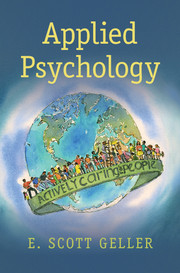Book contents
- Frontmatter
- Dedication
- Contents
- Foreword
- Preface: The Actively Caring for People (AC4P) Movement
- About the Authors
- Acknowledgments
- INTRODUCTION TO PART I EVIDENCE-BASED PRINCIPLES OF AC4P
- INTRODUCTION TO PART II APPLICATIONS OF AC4P PRINCIPLES
- 9 Actively Caring for Occupational Safety
- 10 Cultivating an AC4P Culture in Organizations
- 11 Actively Caring for Traffic Safety
- 12 Actively Caring to Prevent Alcohol Abuse
- 13 Actively Caring for Obesity
- 14 Actively Caring for Patient-Centered Healthcare
- 15 Actively Caring for Our Children
- 16 Actively Caring for Preschoolers
- 17 Actively Caring Coaching for Young Athletes
- 18 Actively Caring for Higher Education
- 19 Actively Caring for Mother Earth
- 20 The AC4P Power of Pets
- Epilogue: Where Do We Go from Here?
- Subject and Name Index
- References
17 - Actively Caring Coaching for Young Athletes
from INTRODUCTION TO PART II - APPLICATIONS OF AC4P PRINCIPLES
Published online by Cambridge University Press: 05 March 2016
- Frontmatter
- Dedication
- Contents
- Foreword
- Preface: The Actively Caring for People (AC4P) Movement
- About the Authors
- Acknowledgments
- INTRODUCTION TO PART I EVIDENCE-BASED PRINCIPLES OF AC4P
- INTRODUCTION TO PART II APPLICATIONS OF AC4P PRINCIPLES
- 9 Actively Caring for Occupational Safety
- 10 Cultivating an AC4P Culture in Organizations
- 11 Actively Caring for Traffic Safety
- 12 Actively Caring to Prevent Alcohol Abuse
- 13 Actively Caring for Obesity
- 14 Actively Caring for Patient-Centered Healthcare
- 15 Actively Caring for Our Children
- 16 Actively Caring for Preschoolers
- 17 Actively Caring Coaching for Young Athletes
- 18 Actively Caring for Higher Education
- 19 Actively Caring for Mother Earth
- 20 The AC4P Power of Pets
- Epilogue: Where Do We Go from Here?
- Subject and Name Index
- References
Summary
Somewhere behind the athlete you've become and the hours of practice and the coaches who have pushed you is a little girl who fell in love with the game and never looked back … play for her.
– Mia HammParticipating in sports is a popular activity for children in the United States. Approximately 35–45 million children between the ages of 6 and 18 participate in some type of organized sport program each year, according to recent estimates. Youth participation in these programs (especially in certain types of sports) varies significantly across gender, race/ethnicity, geographic area, and family socioeconomic status. In total, at least half or up to three-quarters of all children in the United States participate in organized sports.
The number of children (especially girls) who participate in a competitive sport program has increased during the past several decades. There also appears to be a trend toward earlier entry into sports. Today, it's not unusual for children as young as 3 or 4 years of age to be participating in an organized sports program and/or to begin training in what will ultimately be a competitive sport. The intensity of physical training among young athletes may also be increasing, as parents hope to boost their children into higher levels of play.
There is also a trend in certain sports contexts toward earlier sport specialization. Children participate from an early age (e.g., 4 or 5 years) in only one sport (e.g., tennis) to the exclusion of all other physical activities. In previous decades children participated more often in several different sports or physical activities until they were into their adolescent years – at which time they often focused on one sport. It's more common today for children to be asked to, or perhaps pushed to, select one sport at an early age and train year round at that sport for the rest of their athletic career.
Participation in sports occurs during very important growth and development periods in the lives of children and adolescents. Significant developmentally-based changes occur between the ages of 6 and 18 in children's physical, socioemotional, psychological, and cognitive domains, and this development appears to be an interaction of nature and nurture. And so engagement in competitive sports programs can significantly impact a child's development.
- Type
- Chapter
- Information
- Applied PsychologyActively Caring for People, pp. 535 - 562Publisher: Cambridge University PressPrint publication year: 2016

